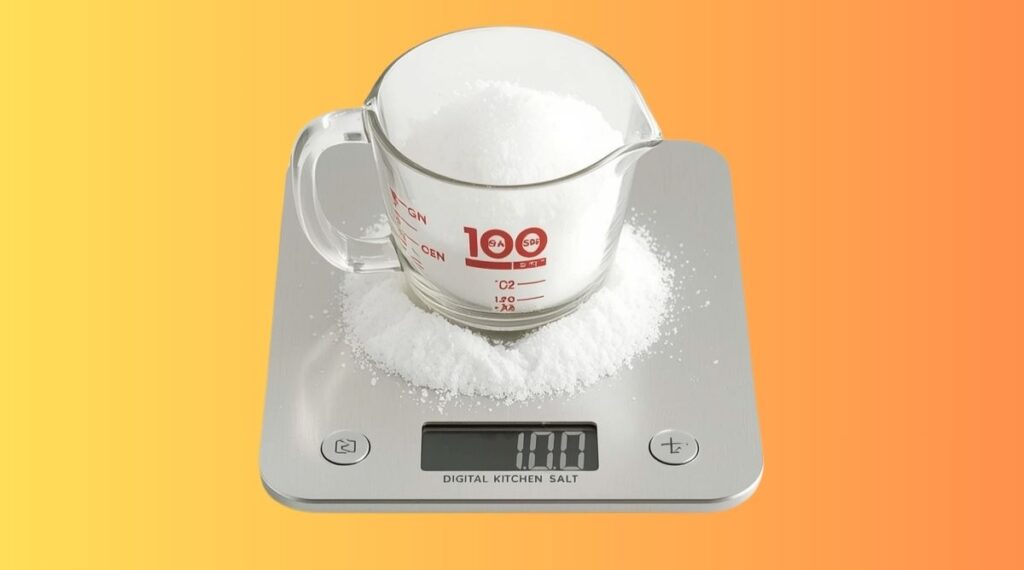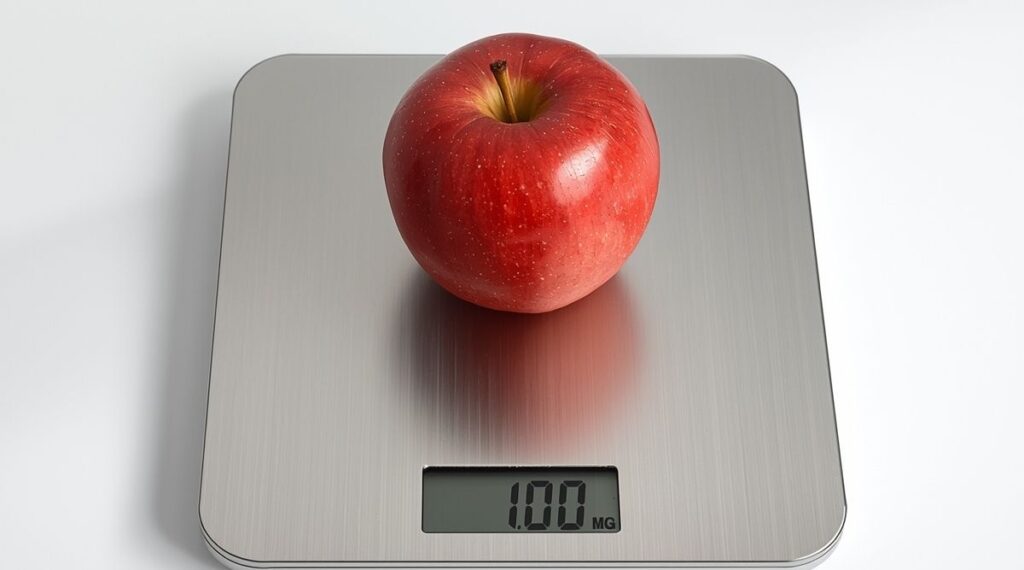How Much Is 100 Grams? 13 Most Common Things That Weigh About 100 Grams
100 grams might seem like a small amount, but it holds immense power in the kitchen and beyond! Whether you’re trying to follow a recipe or manage your diet, knowing exactly how much is 100 grams can make all the difference.
We’ll explore what 100 grams looks like in various contexts, from everyday ingredients to nutritional guidelines. You’ll have a clearer understanding of how to apply 100 grams to your cooking and nutrition decisions effectively.
What Weighs 100 Grams
When considering how much 100 grams weighs, it’s fascinating to explore everyday items that fit this measurement. A medium-sized apple weighs about 100 grams, serving as a helpful weight reference. Holding the apple symbolizes a blend of nutrition and sweetness.
Measuring ingredients in grams improves cooking accuracy. For example, 100 grams of chicken offers 31 grams of protein, while the same amount of broccoli is low in calories yet nutrient-dense.
This highlights the importance of using 100 grams as a standard for balanced meal planning that meets dietary needs and flavor preferences.
How Much Is 100 Grams?
Understanding the conversion of 100 grams into various units is crucial for anyone who navigates the realms of cooking, shipping, or scientific measurements.
Specifically, knowing how many ounces in 100 g can significantly impact the accuracy of a recipe or the precision needed in a laboratory setting.
Understanding 100 grams in various units is essential for accurate conversions.
- In the imperial system, 100 grams equals about 3.527 ounces.
- In metric terms, 100 grams is also 0.1 kilograms or 0.220 pounds.
These conversions are vital for cooking, shipping, and scientific measurements.
Most Common Things That Weigh 100 Grams
- Sugar or Salt
- A Medium-Sized Apple
- All-Purpose Glue
- A Standard Bar Of Soap
- A Kiwifruit/Avocado
- A Newborn Kitten
- A Banana
- A Pocket Knife
- Stick of Butter
- Coins
- Tree Frog
- Two Chicken Eggs
- Apple Magic Mouse
Sugar or Salt
When it comes to the kitchen, precision is key, and understanding what weighs 100 grams can elevate your culinary game.

For instance, half a cup of powdered brown sugar weighs approximately 100 grams (3.5 ounces), making it an easy ingredient to measure for recipes.
This sweet staple not only adds flavor but also moisture to baked goods, demonstrating how the right measurements can yield delicious results.
Salt, an essential pantry item, enhances flavor significantly. Just 100 grams can elevate a dish. Both sugar and salt are common grocery staples that are often overlooked, yet they are crucial for balancing flavors in cooking.
A Medium-Sized Apple
A medium-sized apple, weighing between 100 – 200 grams, strikes the perfect balance for those mindful of their diet.

But how much is 100 g in terms of nutrition? A medium apple has about 52 calories and 4 grams of dietary fiber, aiding weight management. Its size (2.5 to 3 inches) makes it easy to hold and versatile for snacking or adding to salads.
All-Purpose Glue
All-purpose glues are essential household tools used for various tasks, from quick repairs to detailed crafts.

When you reach for a tube of glue, especially the popular 100-gram options from trusted brands like Pritt and Fevicol, you might wonder, “How much does 100 grams weigh?”
The answer lies in the versatility of small-sized glues, which bond various materials effectively. Ideal for home repairs and school projects, they work on paper, wood, and fabric.
A Standard Bar Of Soap
A standard bar of soap, weighing 100 to 150 grams, measures about 3 by 2 inches. Its compact size fits comfortably in the hand, facilitating easy use during daily hygiene routines.
More than just a practical item, it plays a crucial role in health by effectively removing dirt, oil, and impurities from the skin.
In an era where hygiene is paramount, understanding how big is 100 grams in terms of soap emphasizes its importance; it’s a small investment in personal health that yields substantial benefits.
A Kiwifruit/Avocado
Navigating grocery aisles can be challenging due to weight differences. Familiar items like kiwis and avocados help simplify this. A small avocado, size 84, weighs about 100 grams.
This makes it an ideal reference point for anyone trying to visualize how much 100 grams weighs without needing a scale. Imagine holding that creamy fruit in your hand; it not only elevates your meal but also serves as a practical weight guide.
Large kiwifruits weigh 100 to 120 grams, illustrating natural variance in produce. Comparing fruits helps shoppers understand weight, aiding dietary choices and portion control without needing a scale.
A Newborn Kitten
Newborn kittens are nothing short of miraculous, entering the world at a mere 100 grams (3.5 ounces) on average, although some may weigh as little as 80 grams.
Kittens are born small, with closed eyes and folded ears, relying on touch and smell. Their rapid growth is notable; they double their weight by the end of the first week. The umbilical cord typically falls off around three days old, marking a step toward independence.
A Banana
A medium banana, typically around 7 inches long, weighs approximately 120 grams, which is slightly above the 100-gram benchmark many of us often reference.
This makes bananas not only a delicious snack but also a handy tool for visualizing weights in our daily lives. Imagine reaching for a medium banana when you need to estimate 100 grams; it’s a perfect visual cue that bridges nutrition and convenience.
A Pocket Knife
Pocket knives typically weigh 99.22 grams, striking a balance between design and functionality for everyday use. This weight, comparable to a medium apple, ensures they are lightweight yet effective for various tasks.
A standard pocket knife typically has a 3-inch blade and a 4-inch handle, embodying portability and practicality.
Pocket knife weights vary due to diverse designs catering to different needs. Heavier models may feature thicker blades and additional tools, reaching weights of up to 453 grams for multi-tools.
Stick of Butter
Butter serves as a culinary benchmark, with 100 grams commonly referenced for weight. Created by churning cream, its texture and flavor vary based on the cows’ diets.
Grass-fed cows yield butter rich in flavors and omega-3 fatty acids, demonstrating nature’s impact on this simple spread.
Ancient Egyptians utilized Butter for skin nourishment, and traditional remedies highlighted its soothing properties. In the U.S., a stick of butter, about 113 grams or half a cup, is a practical measuring tool for cooks.
Coins
The US nickel weighs 5 grams, and twenty nickels equal 100 grams. Similarly, the British twenty pence coin also weighs 5 grams.
This weight similarity prompts discussions on standardization in global finance, highlighting how different countries use similar physical attributes in their currencies.
Both coins reliably measure 100 grams, inviting reflection on the currency design’s broader implications for commerce and trade.
Tree Frog
Tree frogs are colorful amphibians, measuring 2 to 10 centimeters and weighing 5 to 50 grams. To put this in perspective, two average-sized tree frogs can tip the scales at around 100 grams.
Their small size and light weight enable agile movement in trees, showcasing nature’s ingenuity.
Two Chicken Eggs
Chicken eggs are a versatile and nutritious ingredient, weighing about 50 grams each. Two medium eggs make 100 grams, suitable for many recipes. They can be scrambled, poached, or baked, allowing creativity in cooking.
In a world where nutritious options can be limited, understanding how much is 100 g of chicken eggs can help you appreciate their role as a reliable source of nourishment, helping to bridge dietary gaps and support local farming communities.
Apple Magic Mouse
When considering how much is 100 grams in the realm of computer mice, it’s fascinating to observe the nuances in weight that cater to different user preferences.
The average mouse tips the scales at about 100 grams, a figure that serves as a comfortable midpoint for casual users.
The variance in weight can be striking; with some models weighing as little as 58 grams and others soaring up to 183 grams, this range reflects the diverse needs of today’s digital users.
Also find How Much is 20 kg? (With Pictures)
Conclusion
Understanding how much is 100 grams really can significantly enhance your cooking and nutritional awareness. This measurement serves as a foundation in various recipes and dietary guidelines, helping you to portion ingredients and track your food intake accurately.
By visualizing 100 grams through common items, you can better grasp its significance in everyday life. Whether you’re baking a cake or preparing a healthy meal, knowing this weight can lead to improved outcomes in the kitchen.
FAQs
How Much is 100 Grams in Cups?
Grams to cups conversion varies by ingredient due to differing densities. For example, 100 grams of all-purpose flour is about 0.8 cups, while granulated sugar is roughly 0.5 cups.
What is 100 Grams in Teaspoons?
Converting grams to teaspoons varies by substance due to differing densities. For instance, 100 grams of sugar equals approximately 24 teaspoons, while 100 grams of salt is roughly equivalent to 18 teaspoons. Thus, stating that 100 grams equals 19 teaspoons is inaccurate.
Is 100g the Same as 4 oz?
100 grams is approximately 3.5 ounces, not 4. One ounce equals about 28.35 grams. Thus, 100 grams converts to roughly 3.53 ounces, closer to 3.5 ounces.







